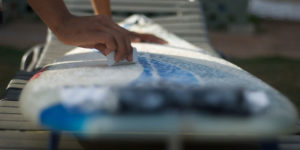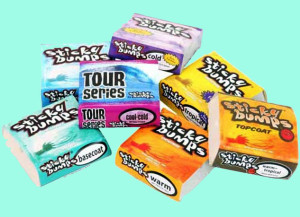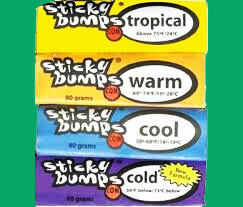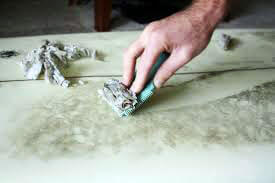How to Clean and Apply Surf Wax to a Surfboard
Surf wax is a gooey material that is rubbed onto the surface of a surfboard to prevent slipping off the surfboard when riding a wave. Surfboards are made out of a foam material and then wrapped in a hard outer surface made with fiberglass and resin. This surface can be very slippery when wet and almost impossible to stay on your surfboard. Surfers use surf wax on the deck, the top part of the board where your feet go, to create traction while standing on the surfboard.
Types of Surf Wax
There are several different types of surf wax and choosing the right one is crucial to whether or not it will be effective. Surf wax comes in Cold, Cool, Warm and Tropical. The temperature of the water where you will be surfing will determine what type you will use.
You want your surf wax to stay tacky as long as possible. If the water is too warm, it will melt off. If the water is too cold, the wax will freeze making the surface very slippery. Choosing the right temperature surf wax will ensure that your surfboard stays under your feet.
Cold Water Surf Wax – This works best in temperatures ranging from 50 to 58 degrees. Areas such as Northern California will require this type of wax for the best performance.
Cool Water Surf Wax– Works best in temperatures ranging from 56 to 68 degrees. Most spots in Southern California will have a water temperature in this range so a cool wax will work perfect. Some brands even carry a Cold/Cool brand just in case the water temp drops overnight.
Warm Water Surf Wax– If it’s a warm in California or a colder day in Kona, Hawaii, a warm water wax will work in water temps ranging from 66 to 76 degrees
Tropical Water Surf Wax– This is your go to wax when surfing in a tropical climate such as Hawaii or Costa Rica. Use this wax when the water temp is 76 degrees and above
Basecoat– The basecoat is a harder wax that should be used on new surfboards that have never been waxed or after you have stripped old wax and ready to put a new coat on. Basecoat does not provide any traction, yet provides a surface for the surf wax to stick to creating a beaded surface of sticky wax. Basecoat wax should be used when applying a cold or cool water wax to increase the tackiness of the wax. Normally, basecoat wax is not needed when applying warm or tropical wax.
How to Clean and Apply Surf Wax
When applying surf wax to a surfboard you must first make sure the deck or surface to the surfboard is clean and free from old wax. If you are waxing a brand new surfboard then you do not have to clean anything. If you are re-waxing a surfboard, then the first step is to remove the old wax.
To remove old surf wax from your surfboard you first need to soften up the wax. You can do this by placing the surfboard in the sun, wax side up. Be careful not to leave the surfboard out in the sun for too long because the heat will cause the surfboard to decay from the inside out. You can also use mineral spirit which will loosen up the old wax.

For the best results, make a checker board pattern with the surf wax then rub the wax in small circles all over the surfboard.
Once soft, use a wax comb or an old credit card to scrap off the old wax. The old wax will leave a tacky residue on the surfboard. This can be easily removed by using mineral spirits and a soft cloth. After the surfboards surface is clean of all old wax, you can begin applying the new coat.
If you are surfing in cold or cool water, it is a good idea to use basecoat wax over the area you want to apply surf wax to.
Application can be done several different ways. You can rub it onto the surfboard using small circles, vertical / horizontal lines, by making a checker board pattern or a combination of the above mention. Whichever method you use, make sure that you apply the wax in the critical areas where your feet will be on the surfboard.
When do I change my surf wax?
Changing your surfboard wax depends on how often you surf. If you surf every day, then there is a good chance that you are going to need to at the very least reapply before every surf session. Over time it will build up and create a gooey and slippery mess. In this event, you can use a wax comb to rough up the built up wax making it tacky again. Eventually however, you are going to have to strip the old wax and reapply a fresh coat.
Foam surfboards, which are used by beginner surfers during surf lessons, do not need to be waxed.









Good tips!
And even though foam boards don’t need wax, they are even gripper if you DO wax them!
Good info,going out on saturday in fuengirola.
Hopefully the waves are coming🏄🏼♂️